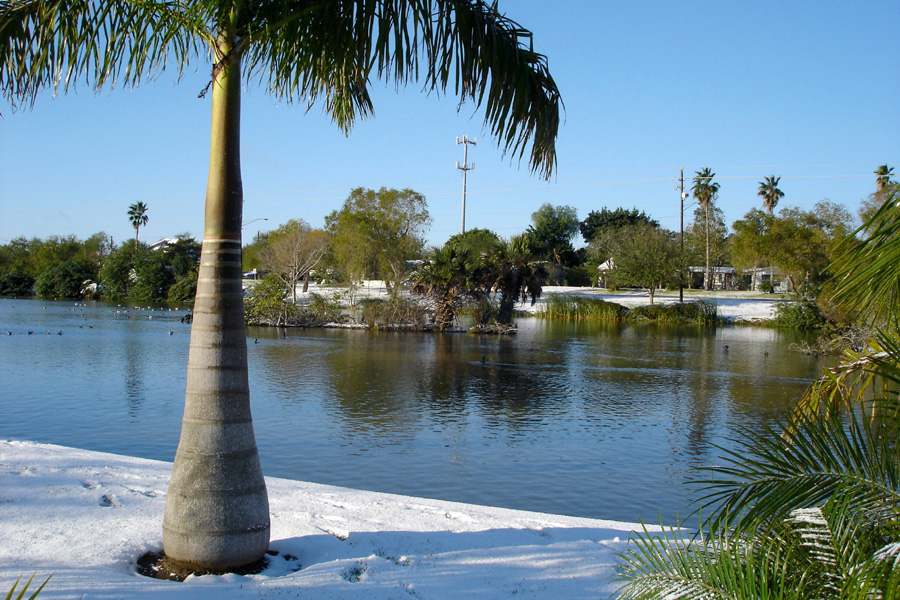So, what exactly is a Winter Texan?
Simply defined, a Winter Texan is a person (usually retired) who comes to Texas to spend a portion of the winter months and then returns to their home state in the summer. The amount of time these winter visitors reside in Texas may vary from a few weeks to several months. Winter Texans are sometimes referred to as "snowbirds". However, here in the Rio Grande Valley we prefer the term "Winter Texan". The term snowbird has gained some notoriety in other sun-belt regions of the United States as a derogatory term used to describe unwanted visitors from out of state. For example, take a look at this blog post from a Florida native.
In the early 1970s "Smokey" Boyle, a lay minister who preached at area RV parks, is credited with originating the term "Winter Texan". Boyle also headed the "Winter Texan" committee with two purposes. "The first is to make them feel welcome and that they are part of the communities in which they spend their winters. The second Is to make local people aware of what these folks really mean to the economy and to encourage a friendly, helpful attitude toward them," Boyle said.
What is the history of Winter Texans?
It can be said that the "Winter Texan Movement" began in the early 1900s when Rio Grande Valley landowners actively marketed the "Magic Valley" as a place where crops could be grown all year long.
 Land companies advertised in northern USA cities and provided train transport for prospective buyers. This resulted in trainloads of mid-westerners coming to the Valley. Of course when they got here, they noticed that the region is not a valley at all, but rather a delta region of the Rio Grande river. Development of irrigation networks had however created a fertile growing region, so many of them purchased land and began growing produce and citrus crops. Many were successful in their farming enterprises while others began other businesses contributing to the economic growth of the region.
Land companies advertised in northern USA cities and provided train transport for prospective buyers. This resulted in trainloads of mid-westerners coming to the Valley. Of course when they got here, they noticed that the region is not a valley at all, but rather a delta region of the Rio Grande river. Development of irrigation networks had however created a fertile growing region, so many of them purchased land and began growing produce and citrus crops. Many were successful in their farming enterprises while others began other businesses contributing to the economic growth of the region.

Some of these early Valley pioneers endured the hot summer months while others preferred to spend their summers in the milder climate of their home state.
One such example is Bessie Glick who came down on an excursion train in 1926, liked what she saw and purchased land. Unable to cope with the heat of the summer, Bessie would make the long journey to and from Paris, Illinois with the changing seasons, first in her Model T and later in a Model A Ford. Her sons started an army surplus store after WWII which is now Glick Twins located in Pharr, Texas. Read more about Bessie Glick and Glick Twins

Before the development of campgrounds and RV parks Winter Texans would stay with relatives or in hotels such as the Casa de Palmas in McAllen, Texas (pictured here in 1920). As the RV industry developed in the 1920s and 1930s RVers would park wherever they could find an empty space offered for their use. These early RVs had none of the conveniences we enjoy today, such as toilets, showers and kitchens. Read about the History of RVs here.
When building materials became more available following WWII, enterprising landowners began developing more modern campgrounds. One of the first to do so was Charles Hazzard who built Holiday Village RV Park at the intersection of HWY 281 and HWY 83 in Pharr, Texas.
In the early 1960s the city of Harlingen, Texas began an accelerated campaign of advertising to entice Mid-West retirees. $100,000 was spent on
national advertising in several metropolitan newspapers located in northern states. 1966 The first recreational vehicle caravan rally is brought to town.
 In 1967 Hank Stanley, a Harlingen realtor, leases city land at the site of the old Harlingen Air Force Base which closed in 1962. He then offers trailer and RV hookup pads, 150 the first year, at his Fun N Sun RV Resort. By year three, this has grown to 550. He also worked with travel trailer manufacturers to bring touring caravans to the Valley. This became a nucleus for new customers. The Harlingen Chamber of Commerce helped by launching a promotional campaign aimed at turning Harlingen into a destination for Midwestern snowbirds. The concept at progressive parks was to provide activities for leasers. These included exercise and aerobics classes, dances and live music, arts and crafts, swimming, etc. By 1981 Stanley's resort had outgrown its Harlingen site, so he opened a new one just over the city line in San Benito. It offered 1,300 trailer hookup sites, making it the largest such park in Texas. Hank Stanley is largely credited with laying the foundation for the RGV's RV industry and by 2004 the Valley RV parks could serve up to 60,000 units.
In 1967 Hank Stanley, a Harlingen realtor, leases city land at the site of the old Harlingen Air Force Base which closed in 1962. He then offers trailer and RV hookup pads, 150 the first year, at his Fun N Sun RV Resort. By year three, this has grown to 550. He also worked with travel trailer manufacturers to bring touring caravans to the Valley. This became a nucleus for new customers. The Harlingen Chamber of Commerce helped by launching a promotional campaign aimed at turning Harlingen into a destination for Midwestern snowbirds. The concept at progressive parks was to provide activities for leasers. These included exercise and aerobics classes, dances and live music, arts and crafts, swimming, etc. By 1981 Stanley's resort had outgrown its Harlingen site, so he opened a new one just over the city line in San Benito. It offered 1,300 trailer hookup sites, making it the largest such park in Texas. Hank Stanley is largely credited with laying the foundation for the RGV's RV industry and by 2004 the Valley RV parks could serve up to 60,000 units.
According to UTRGV's Business and Tourism Research Center the Winter Texan population in the Rio Grande Valley reached a record level of 144,000 in the winter of 2009-2010. Since 2010 the number of winter visitors has steadily decreased and it is currently estimated to be less than 100,000 (2018).
Where do Winter Texans live in Texas? (Winter Texan Communities)
There are three main areas of distribution for the Winter Texan population, The Rio Grande Valley, the Texas Hill Country and the Texas Gulf Coast. While in Texas, most Winter Texans live in Mobile Home & RV Park Resorts. The Rio Grand Valley alone has over 200 such parks. These resort parks come in all sizes from the "mom & pop" small park with as few as 30 sites to the mega corporate owned giants with over 1000 sites. Some are HOAs where the resident purchases the lot they live on while most are rented lots. Current trends show that more Winter Texans are purchasing mobile homes in the parks than those coming in RVs. Many Winter Texans stay in extended stay hotels or condominiums. Some have retired to the Valley permanently and own homes in the general population or in country clubs and other subdivisions.
Most of the Winter Texan communities are designated as 55+ only. Due to the decline in the Winter Texan population over recent years, some of the smaller RV/Mobile Home parks have opted to allow younger residents, and some have opened to families as well.
The region of Texas chosen by Winter Texans largely depends on their individual requirements. If a person wants to stay where it is likely to be warmest all winter long, the Rio Grande Valley (RGV) is the preferred winter destination. In the RGV during the coldest winter months, the average low temperature is around 51° F with an average high in the low 70s.
 A person who enjoys a brisker climate may choose the Texas Hill Country or the Upper Gulf Coast where wintertime lows are in the forties with highs in the sixties.
Source: usclimatedata.com
A person who enjoys a brisker climate may choose the Texas Hill Country or the Upper Gulf Coast where wintertime lows are in the forties with highs in the sixties.
Source: usclimatedata.com
Even though the winter climate is moderate, winter weather can not be ruled out for any of these regions. Snowfall is rare but does occur occassionally. For example: In 2004 the Rio Grande Valley, Texas' most southern region, experienced a "White Christmas". This was the first measurable snowfall to be witnessed by local residents for three generations.
Read about RGV White Christmas here
At any rate, winter in Texas is far less frigid than in the northern US and Canada. This is why so many people make Texas their number one Winter Vacation Destination.
Another consideration when choosing your wintering home is your lifestyle. Many retirees live an active life full of outdoor activities such as fishing, hiking, boating, golf, birding etc.
All three regions, Hill Country, Upper Gulf Coast and RGV, offer all of these activities. Fresh water lakes and rivers provide an abundance of fishing and boating options as well as salt water fishing in the Gulf of Mexico.
Beautiful state parks and forests are full of hiking trails and birding opportunities. There are hundreds of golf courses to choose from. It may be a good plan to try a variety of these choices in order to find the one which suits you the best.
Here are some resources to use:
RV resorts and campgrounds in Texas (map)
Texas Hill Country info
Over 200 RV/Mobile Home resorts and everything you want to know about the Rio Grande Valley